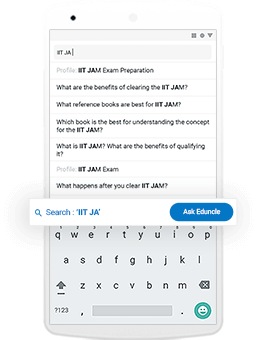Time management is very much important in IIT JAM. The eduncle test series for IIT JAM Mathematical Statistics helped me a lot in this portion. I am very thankful to the test series I bought from eduncle.
Nilanjan Bhowmick AIR 3, CSIR NET (Earth Science)
P
Priya Lahorani posted an Question
October 01, 2022 • 05:20 am
![]() 30 points
30 points
- CSIR NET
- Life Sciences
Explain platelet plug formation
explain platelet plug formation in hemostasis how von willebrand factor is formed
1 Answer(s)
Answer Now
- 0 Likes
- 1 Comments
- 0 Shares
-
P
T
Do You Want Better RANK in Your Exam?
Start Your Preparations with Eduncle’s FREE Study Material
- Updated Syllabus, Paper Pattern & Full Exam Details
- Sample Theory of Most Important Topic
- Model Test Paper with Detailed Solutions
- Last 5 Years Question Papers & Answers
Sign Up to Download FREE Study Material Worth Rs. 500/-

















Priya sarda![best-answer]()
The platelet plug, also known as the hemostatic plug or platelet thrombus, is an aggregation of platelets formed during early stages of hemostasis in response to one or more injuries to blood vessel walls. After platelets are recruited and begin to accumulate around the breakage, their “sticky” nature allows them to adhere to each other. This forms a platelet plug, which prevents more blood from leaving the body as well as any outside contaminants from getting in. The plug provides a temporary blockage of the break in the vasculature. As such, platelet plug formation occurs after vasoconstriction of the blood vessels but before the creation of the fibrin mesh clot, which is the more permanent solution to the injury. The result of the platelet plug formation is the coagulation of blood. It can also be referred to as primary hemostasis. Platelet plug formation occurs in three major steps: Platelet activation Under normal physiological conditions, blood flows through the body without any noticeable aggregation of platelets. This is because platelets are not initially programmed to accumulate by themselves because this could cause an undesirable thrombosis. However, during hemostasis, coagulation is desired. As such, the platelets in the plasma must be alerted to the need for a plug formation. Any discontinuity detected in the vascular endothelium triggers an automatic response in the clotting system, which in turns stimulates thrombin production. Thrombin also causes platelet aggregation. As such, more often than not, platelet adhesion and activation occur in overlapping steps, where one directly influences and contributes to the other. Platelet adhesion Once platelets are activated, when they come across injured endothelium cells, the von Willebrand factor (vWF) and fibrinogen will act as anchors to allow platelets to adhere onto the vessel wall. These molecules are released from the platelet themselves as a result of degranulation, a physiological change in the platelet's shape due to the secretion of the contents of the dense granules and alpha granules.From the dense granules, serotonin and adenosine triphosphate are released. From the alpha granules come molecules such as the platelet-derived growth factor, fibrinogen, and the von Willebrand factor (vWF), a glycoprotein critical in platelet activation and adhesion. The ADP secreted from the dense granules then binds to receptors on the membrane of platelets. However, to allow for platelet adhesion to occur requires an additional molecule. Glycoprotein lb is a protein on the surface of the platelet membrane that binds to vWF. When vWF is bound to glycoprotein lb, it helps the platelet interact with other surfaces, like the inside of a damaged vessel wall. At high shear stress levels, the GP1b-von Willebrand Factor will initiate the platelet adhesion. This process will then be mediated by integrins, such as β1 (α2β1, α5β1) and β3 (αIIbβ3) integrins. In addition, platelets are activated, they will also change shape in their cortical actin cytoskeleton. The platelets will transform from smooth, biconcave discs to fully spread cells. This dramatically increases their surface area and therefore allows for both increased blockage of the damaged cells as well as more space for adhesion to occur. Platelet aggregation After platelets make contact with the focal point of the vascular injury, they begin to interact with each other to form a platelet aggregate. Platelet aggregation is mainly mediated by β3 (αIIbβ3) integrin and its ligands, such as vWF and fibrinogen] While platelet membranes have binding sites for fibrinogen, they must be induced by thrombin. Thrombin triggers the binding of the adhesive platelets with vWF and fibrinogen.ADP can then catalyze the aggregation of platelets, allowing for fibrinogen to link two platelets together. As more platelets accumulate, they release more chemicals, which in turn attract even more platelets. This is a positive feedback loop that eventually results in the formation of the platelet thrombus.